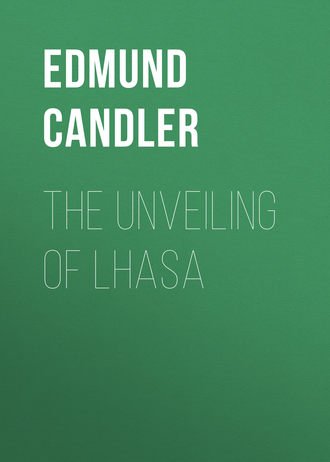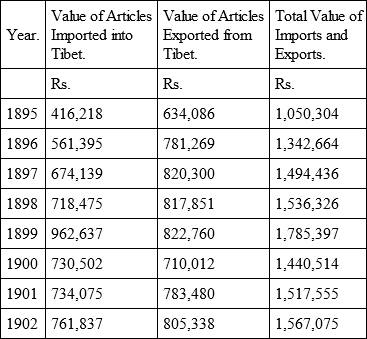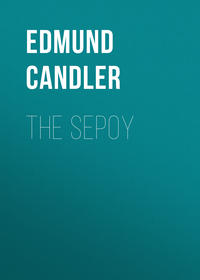 полная версия
полная версияThe Unveiling of Lhasa
8
Sheepskin.
9
The only articles imported to the value of £1,000 are cotton goods, woollen cloths, metals, chinaware, coral, indigo, maize, silk, fur, and tobacco.
The only exports to the value of £1,000 are musk, ponies, skins, wool, and yaks'-tails.
Appended are the returns for the years 1895-1902:

Customs House Returns, Yatung.
10
Between Gnatong and Gautsa, thirteen different species of primulas are found. They are: Primula Petiolaris, P. glabra, P. Sapphirina, P. pusilia, P. Kingii, P. Elwesiana, P. Capitata, P. Sikkimensis, P. Involucra, P. Denticulata, P. Stuartii, P. Soldanelloides, P. Stirtonia.
11
The species are: Rhododendron campanulatum, purple flowers; R. Fulgens, scarlet; R. Hodgsonii, rose-coloured; R. Anthopogon, white; R. Virgatum, purple; R. Nivale, rose-red; R. Wightii, yellow; R. Falconeri, cream-coloured; R. cinndbarinum, brick-red ('The Gates of Tibet,' Appendix I., J. A. H. Louis).
12
When Colonel Bromhead pursued a Tibetan unarmed. Called upon to surrender, the Tibetan turned on Colonel Bromhead, cut off his right arm, and badly mutilated the left.
13
The reports sent home at the time of the Hot Springs affair were inaccurate as to the manner in which I was wounded, and also Major Wallace Dunlop, who was the only European anywhere near me at the time. Major Dunlop shot his own man, but at such close quarters that the Tibetan's sword slipped down the barrel of his rifle and cut off two fingers of his left hand. General Macdonald and Captain Bignell, who shot several men with their revolvers, were standing at the corner where the wall joined the ruined house, and did not see the attack on myself and Dunlop.
14
Companies of Pathans and Gurkhas were left to garrison Ralung, Nagartse, Pehte, Chaksam, and Toilung Bridge.
15
Waddell, 'Lamaism in Tibet,' p. 200.
16
Ibid., p. 409.
17
The only expedition sanctioned is that which is now exploring the little-known trade route between Gyantse and Gartok, where a mart has been opened to us by the recent Tibetan treaty. The party consists of Captain Ryder, R.E., in command, Captain Wood, R.E., Lieutenant Bailey, of the 32nd Pioneers, and six picked men of the 8th Gurkhas. They follow the main feeder of the Tsangpo nearly 500 miles, then strike into the high lacustrine tableland of Western Tibet, passing the great Mansarowar Lake to Gartok; thence over the Indus watershed, and down the Sutlej Valley to Simla, where they are expected about the end of January. The party will be able to collect useful information about the trade resources of the country; but the route has already been mapped by Nain Singh, the Indian surveyor, and the geographical results of the expedition will be small compared with what would have been derived from the projected Tengri Nor and Brahmaputra trips.
18
It is interesting to compare Grueber's account with the journal of Father Rubruquis, who travelled in Mongolia in the thirteenth century. In 1253 he wrote of the Lamas:
'All their priests had their heads shaven quite over, and they are clad in saffron-coloured garments. Being once shaven, they lead an unmarried life from that time forward, and they live a hundred or two of them in one cloister… They have with them also, whithersoever they go, a certain string, with a hundred or two hundred nutshells thereupon, much like our beads which we carry about with us; and they do always mutter these words, "Om mani pectavi (om mani padme hom)" – "God, Thou knowest," as one of them expounded it to me; and so often do they expect a reward at God's hands as they pronounce these words in remembrance of God… I made a visit to their idol temple, and found certain priests sitting in the outward portico, and those which I saw seemed, by their shaven beards, as if they had been our countrymen; they wore certain ornaments upon their heads like mitres made of paper.'
19
'It may be asked how the monastic influence is brought to bear on a Government in which three out of the four principal Ministers (Shapé) are laymen. The fact seems to be that lying behind the Tak Lama, the Shapés, and all the machinery of the Tibetan Government, as we have hitherto been acquainted with it, there is an institution called the "Tsong-du-chembo," or "Tsong-dugze-tsom," which may reasonably be compared with what we call a "National Assembly," or, as the word implies, "Great Assembly." It is constituted of the Kenpas or Abbots of the three great monasteries, representatives from the four lings or small monasteries actually in Lhasa city, and from all the other monasteries in the province of U; and besides this, all the officials of the Government are present – laymen and ecclesiastics alike – to the number of several hundreds.' – Captain O'Connor's Diary at Khamba Jong (Tibetan Blue-Book, 1904).
20
I have derived most of my information regarding the discipline and constitution of Depung from 'Lamaism in Tibet,' by Colonel Augustine Waddell, who accompanied the expedition as Archæologist and Principal Medical Officer.
21
The highest degree which is conferred on the Lamas by their Universities is the Rabs-jam-pa (verbally overflowing endlessly). – Waddell, 'Lamaism in Tibet.'
22
The liberation of the Lachung men and the destruction of the Yatung and Gob-sorg barriers.
23
The following is a draft of the terms as communicated by The Times Correspondent at Peking. The terms have not yet been disclosed in their final form, but I understand that Dr. Morrison's summary contains the gist of them:
'1. Tibetans to re-erect boundary-stones at the Tibet frontier.
'2. Tibetans to establish marts at Gyangtse, Yatung, Gartok, and facilitate trade with India.
'3. Tibet to appoint a responsible official to confer with the British officials regarding the alteration of any objectionable features of the treaty of 1893.
'4. No further Customs duties to be levied upon merchandise after the tariff shall have been agreed upon by Great Britain and the Tibetans.
'5. No Customs stations to be established on the route between the Indian frontier and the three marts mentioned above, where officials shall be appointed to facilitate diplomatic and commercial intercourse.
'6. Tibet to pay an indemnity of £500,000 in three annual instalments, the first to be paid on January 1, 1906.
'7. British troops to occupy the Chumbi Valley for three years, or until such time as the trading posts are satisfactorily established and the indemnity liquidated in full.
'8. All forts between the Indian frontier on routes traversed by merchants from the interior of Tibet to be demolished.
'9. Without the consent of Great Britain no Tibetan territory shall be sold, leased, or mortgaged to any foreign Power whatsoever; no foreign Power whatsoever shall be permitted to concern itself with the administration of the government of Tibet, or any other affairs therewith connected; no foreign Power shall be permitted to send either official or non-official persons to Tibet – no matter in what pursuit they may be engaged – to assist in the conduct of Tibetan affairs; no foreign Power shall be permitted to construct roads or railways or erect telegraphs or open mines anywhere in Tibet.
'In the event of Great Britain's consenting to another Power constructing roads or railways, opening mines, or erecting telegraphs, Great Britain will make a full examination on her own account for carrying out the arrangements proposed. No real property or land containing minerals or precious metals in Tibet shall be mortgaged, exchanged, leased, or sold to any foreign Power.
'10. Of the two versions of the treaty, the English text to be regarded as operative.'
The ninth clause, which precludes Russian interference and consequent absorption, is of course the most vital article of the treaty.
24
The Amban or Chinese Resident in Lhasa is in the same position as a British Resident in the Court of a protected chief in India. Of late years, however, the Amban's authority has been little more than nominal.




